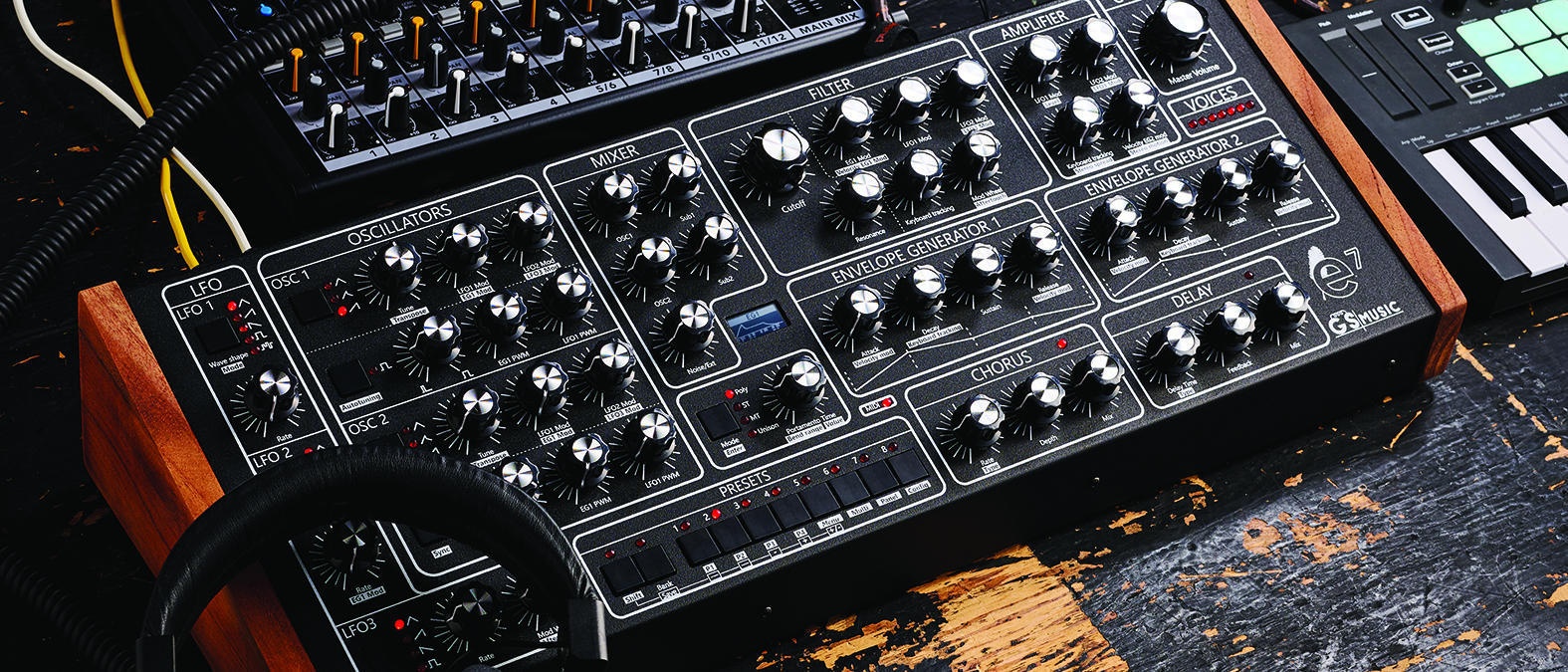MusicRadar Verdict
Great analogue polysynth with classic features and its own personality. Lovely additions and easy operation put it at the top of its range.
Pros
- +
Great-sounding and characterful analogue polysynth.
- +
Very easy to use with (nearly) one-control-per-function system.
- +
Keyboard tracking options are excellent.
Cons
- -
Effects are of fairly average standard.
- -
Multi-mode can be a little hard to use.
MusicRadar's got your back
GS Music e7: What is it?
GS Music says e7 is the first polyphonic analogue synth ever created in Argentina and if that is the case, it’s quite a debut.
The synth packs in a lot for its asking price including seven notes of polyphony which can be delivered at once or over a four-part multitimbral engine. And as well as its modern design and features, it boasts an individual sound while still harking back to some of the best synths ever released. It’s like GS Music had “best of” written on that drawing board, alongside “make it easy to use”.
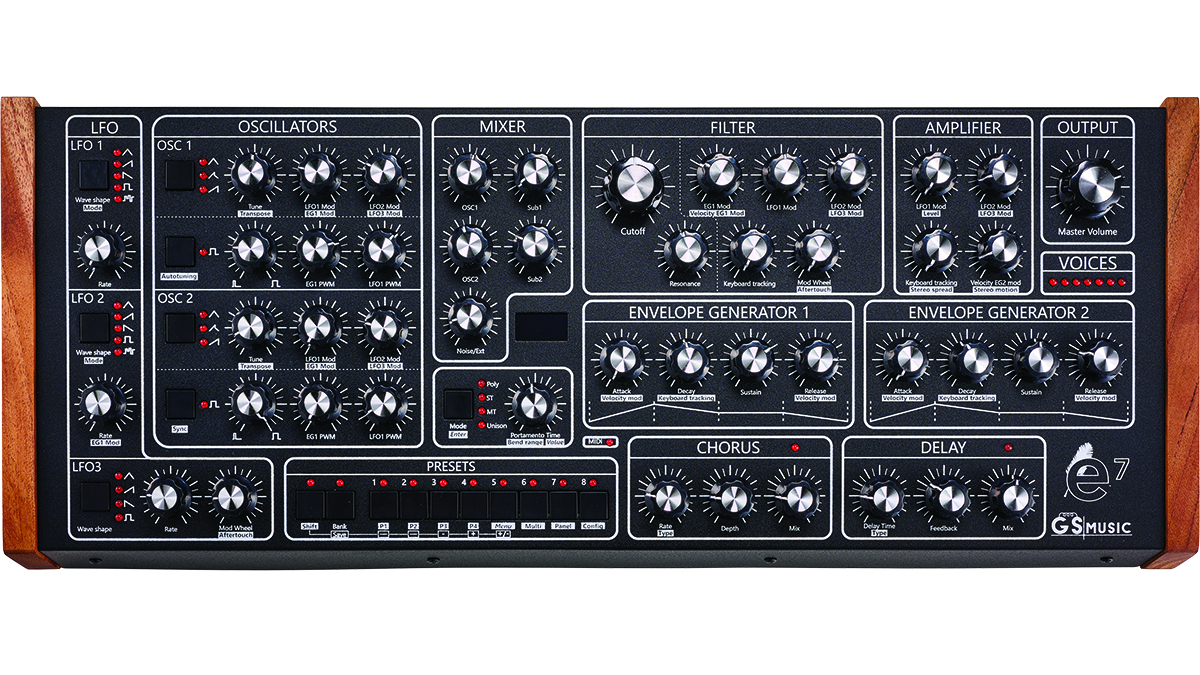
e7 by no means feels like a first attempt at a polysynth. It’s very well built, available in four colours, looks incredibly cool and, more importantly, feels welcoming. This is largely down to its emphasis on one control per operation so its 40+ large dials do the important tweaking with a single Shift button opening the door to the rest.

GS Music e7: Performance and verdict
e7 is a classic subtractive analogue synth with one or two curveballs, so you get a pretty standard oscillator, filter, amplifier and modulation setup but some quirky and not so quirky extras and easy-to-use options take the synth to the next level.
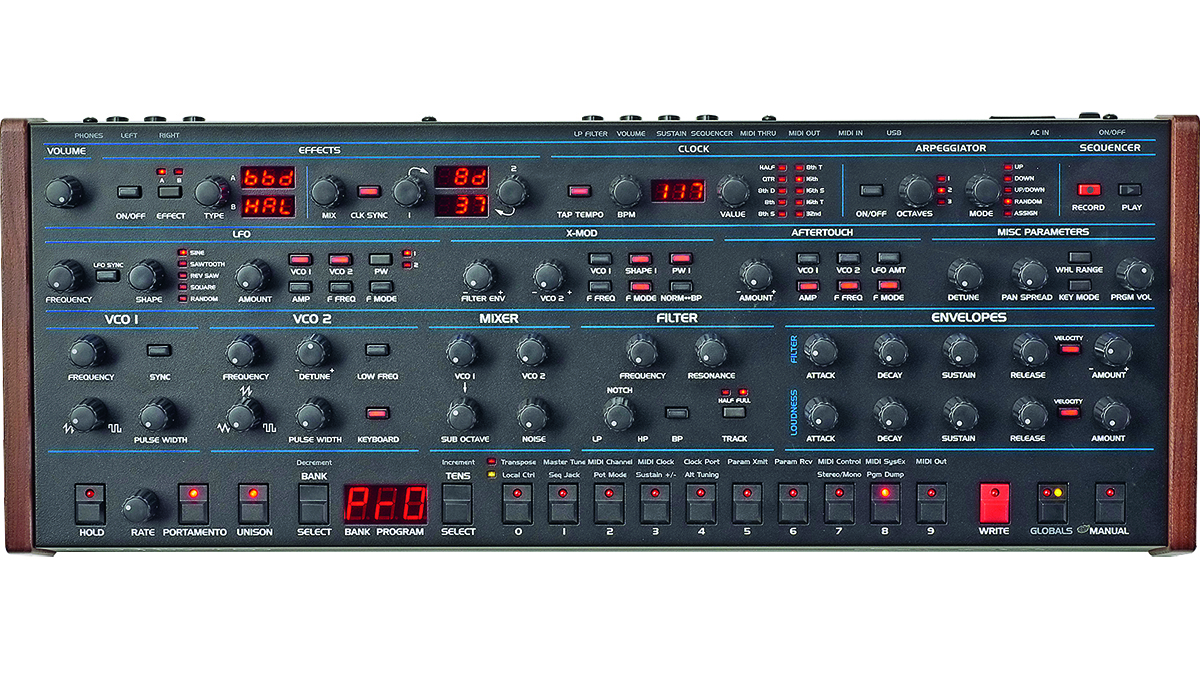
• Sequential/Dave Smith OB-6
Similar analogue architecture and polyphony – and both synths share a superb analogue sound – but you pay extra for more (and better) effects, an additional sequencer, arpeggiator and a more flexible filter setup.
• Korg Minilogue XD
An 8-voice Prologue (now discontinued) is a better comparison, but Minilogue XD will do! Less polyphony and it’s arguably less characterful than e7 – but just look at the price. Buy two and you’ve got a monster analogue synth setup.
• Access Virus TI2
It’s not an analogue synth, but it’s as good as any virtual one that you’ll find, and has more polyphony, multitimbrality and history than just about any other VA synth on the market.
There are two identical oscillators per voice that generate triangular, tri-saw, and sawtooth waveforms – with each linked to a variable pulse width generator – plus a sub-oscillator for each and noise. The filter is a low-pass VCF with a 24dB/Oct slope. There are five options here to modulate the filter frequency which we’ll come to shortly, although the Velocity EG is worth highlighting now as it modulates the frequency based on velocity – the harder you hit, the more drama you get. A dedicated Keyboard Tracking dial – a big feature in e7’s character, as we’ll discover – can also be set to determine how the frequency changes depending on the note you play.
Keyboard Tracking is also a feature in the Amplifier section, where it determines volume level as you play up or down. Unusually, you also get two Stereo controls here to determine not only the spread of all seven voices but their movement across the stereo space.
Main modulation comes by way of three LFOs and a couple of envelope generators. The LFOs have dedicated switches for selecting one from five waveshapes for each – triangle, ramp up, ramp down, square or noise/sample & hold – plus a Rate dial.
Want all the hottest music and gear news, reviews, deals, features and more, direct to your inbox? Sign up here.
The modulation setup is a little confusing until you realise that e7’s (almost) one-control-per-action ethos pretty much dictates everything. For both oscillators, this means two dedicated controls for each to control pitch modulation via LFO 1 and 2. Press Shift and you modulate pitch via LFO 3 and EG1. The filter and amplifier sections have similar controls to modulate the frequency and amplitude by all three LFOs and EG1. You also get to modulate the pulse width of each oscillator with EG1 and LFO1 by way of two dedicated controls next to each oscillator. And we should also mention that aftertouch and the mod wheel can be applied to LFO3 via a dedicated control (and Shift) and both can be applied to filter frequency. That’s a total of seven sources instantly accessible to modulate the filter frequency, so you can already see that there’s a lot of dynamic potential here.
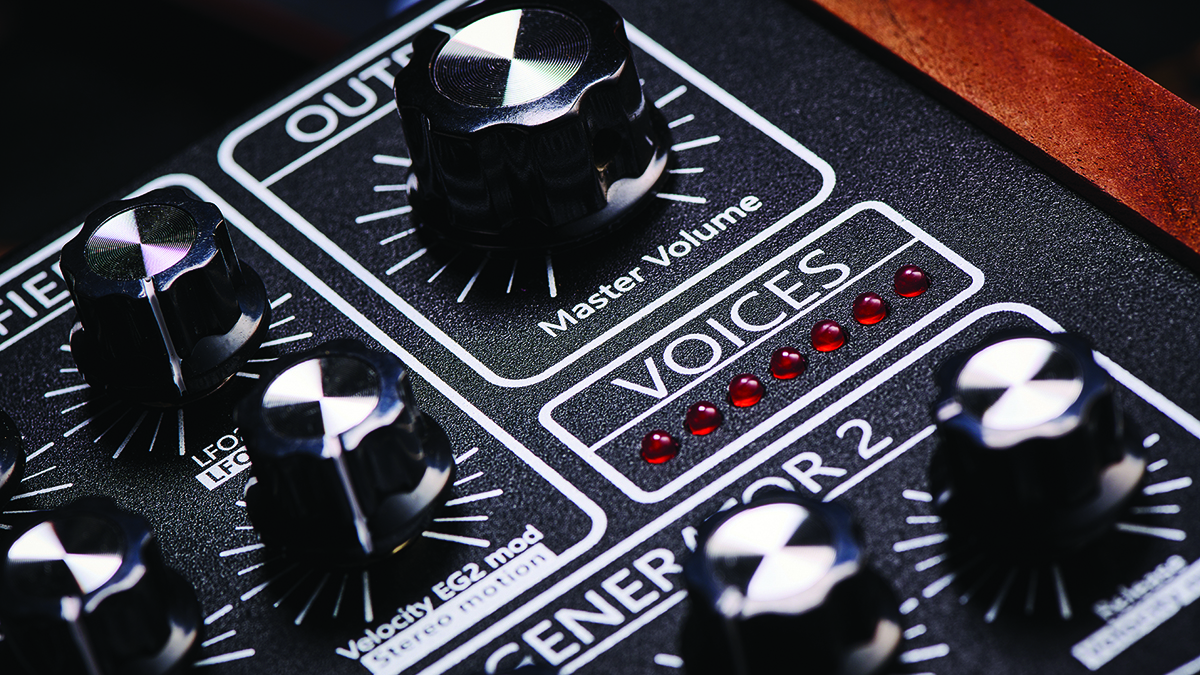
The envelopes have a couple of interesting additions. Each features a Velocity Mod option on the attack and release dials (via Shift), which can be used to set how fast the envelope operates for either or both, depending on the note velocity. Play a note harder, and not only will a note play louder, but it will come in and/or die away quicker; play it softer and the envelope reaches its maximum and minimum positions slower. Nice touch. And linked to this is the ability to add (here it is again) Keyboard Tracking to the envelope so it transits at different speeds depending on where you play on the keyboard – slower at the bottom, faster at the top. Both of these additions are more for performance and playing but neat touches nonetheless.
Finally, LFOs 1 and 2 have six modes. There’s Monophonic, which is the standard operation where the LFO applies to all voices in phase. Polyphonic plays the modulation on each note at a slightly different frequency for more complex sounds. Keyboard Tracking – here it is again – alters the LFO rate as you play up or down the keyboard. The last sync options (Keyboard and Clock) lock the LFOs to a detected bpm clock signal or keeps them in time as multiple keys are played.
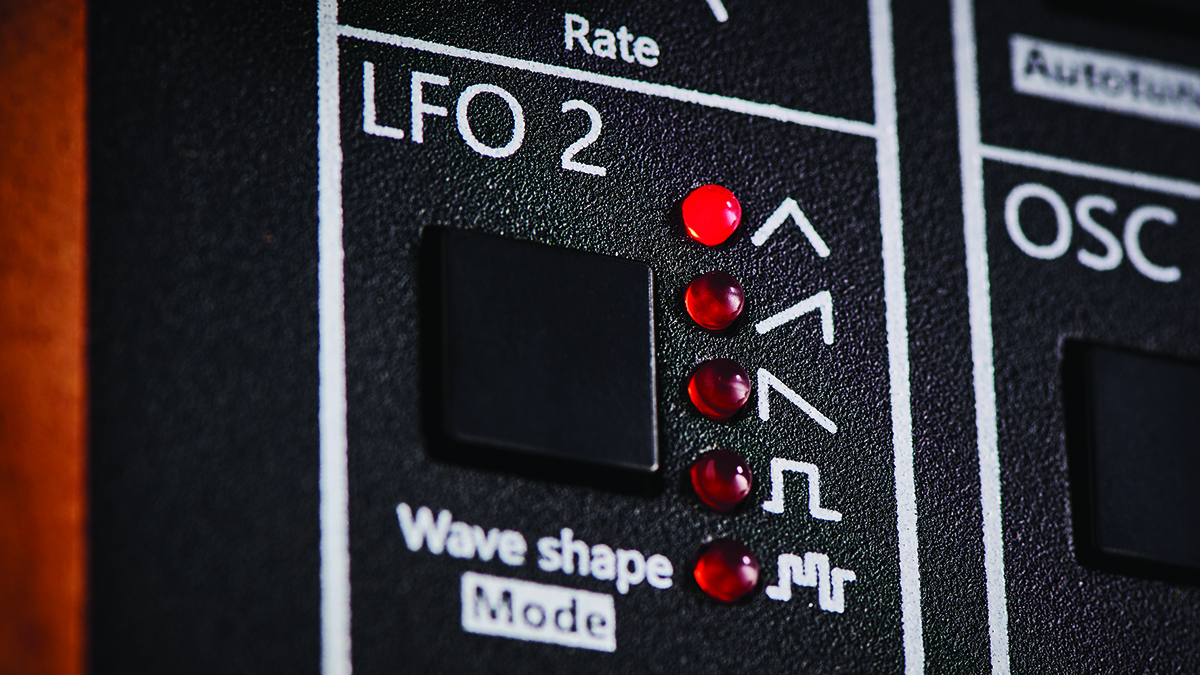
Easy now
If that all seems extensive and perhaps a little complex, it is the former but not the latter. Thanks to that one dial (plus Shift) per operation, it all becomes intuitive, quickly. And the central screen really comes into its own – and throughout the e7 operation – to make the synth a joy to use. Initially, we thought it was more of an afterthought, a screen thrown into a classically styled synth to give it some modern sensibilities, but it’s more than that. It is tiny, for sure, but manages to throw you an awful lot of information like a waveshape graphic, rate or pitch value, the level of five sources modulating the frequency, or even a graphic of that frequency. It imparts way more than its size suggests and is a brilliant design in a tiny area.
The central screen really comes into its own, to make the synth a joy to use
Not only is the screen physically central in e7, it’s central to the entire easy operation. Once you get your head around the fact that there’s really only one layer of menus to dive into, you understand that e7 is very much a WYSIWYG synth – the best type, then. And like the best synths, it offers plenty to do, but very easy routes by which to do it, so while the modulation is generous, e7 will encourage you to get in there and create some glorious sounds along the way. Although someone has done that for you…
The manual suggests just 56 presets are available with a good 512 total locations in which to store more, but we have two banks of 56 and 64 respectively in our test machine. Initial worries that this e7 is about pads only, or just focussing on a ’70s and ’80s vibe are soon dismissed. There are plenty of dreamy pads, with a lot of movement as the keyboard tracking comes into its own as you play, but there’s a good cross-section of other presets to stretch the analogue engine, through organs, basses (including 303-style), plenty of dance leads and more contemporary synth wave and pop basses and leads. With all of those locations spare, though, e7 is encouraging programming, and with the direct controls and ample, instant modulation, you’ll be doing just that.

Multitimbral mode
Entering e7’s multi-mode lets you play up to four different sounds (parts) at once. You’re effectively sharing the seven notes of polyphony at your disposal between these, so it’s not like you’re multiplying the synth by four. But you can get interesting setups like a split keyboard with one sound at the bottom, another at the top; or combinations of very different sounds; or even different sounds triggering on different MIDI channels. There aren’t many presets on show to demo this – a paltry eight – so it’s left to you to experiment. This can be a little hit-and-miss as you’re suddenly required to step through a few menus to set up key ranges, MIDI channels, copy presets to parts, and so on.
It’s cleverly implemented, given the screen size and complexity of your actions, but also taking you out of the very comfortable zone you’ve been in elsewhere with e7’s one-control-per-function operation. However, it’s a nice addition, especially for performing, though we’re not sure we’d have e7 set up and triggered by different MIDI channels in an old-school digital sound module way as its seven voices will quickly be stretched.
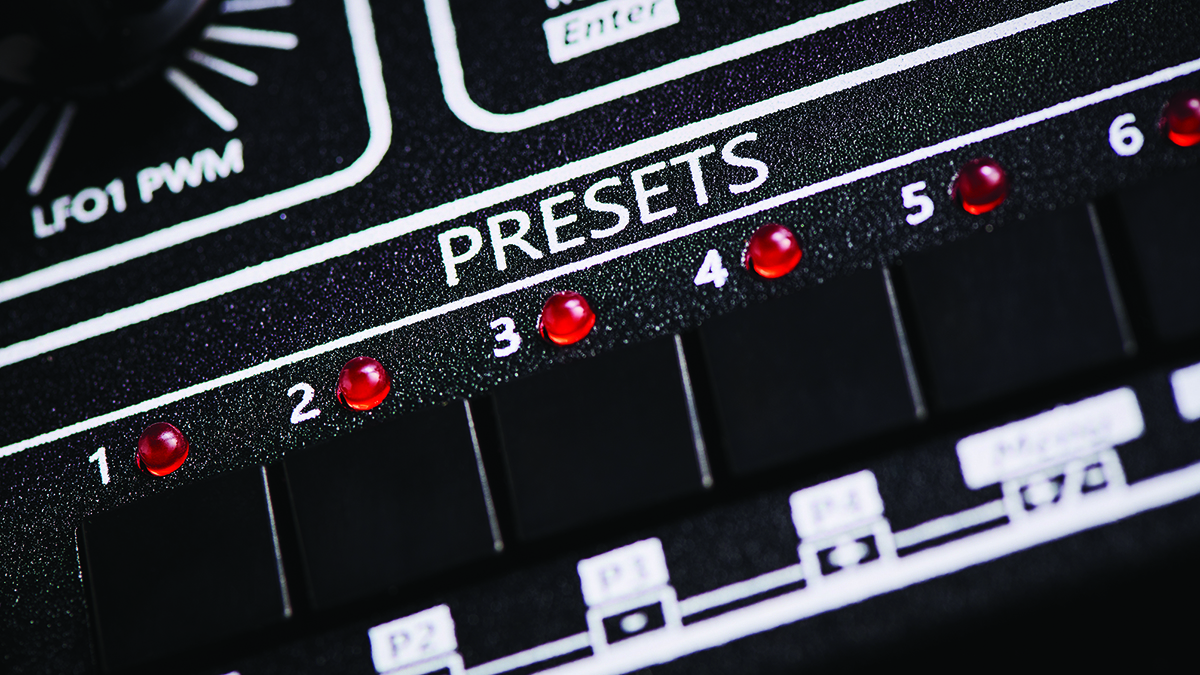
The price is right?
e7 is a superb-sounding analogue synth with some lovely extras and a keen price that set it well apart from – and above – other analogue polysynths. The multitimbral mode is just one extra feature that helps it carve a fairly unique path, but really it’s the sound, operation and execution that have us most excited. The modulation features are not as extensive as on some analogue polys but the important thing is that they are right there in front of you, demanding that you use them to create even more sounds than the many on offer. And that you will, because this is one of the most inviting and intuitive synths out there.
e7 is not without limitations though. We’d have loved some extras which would have no doubt impacted the price – better effects would be good – but it’s that price and the sonic character that also make e7 such an attractive proposition.
But talking of the price, this is where it could get complicated. At $1600, e7 is a steal and we’d have no hesitation recommending it. Get it now… if you can. The problem is that because it’s made in Argentina, you will probably have to add import duty (unless you live in Argentina, obviously) and this can be as much as an eye-watering 22%!
In this case you might be better off buying from your local distributor so you don’t get hit with any unexpected costs, so in the UK, for example, you could buy direct from KMR or Juno Records which nudges the price up to £1600. Even at this price though, you’d be hard pressed to find anything with this sonic character and flexibility even for this increased outlay. How much are those flights to Argentina again?
MusicRadar verdict: Great analogue polysynth with classic features and its own personality. Lovely additions and easy operation put it at the top of its range.
GS Music e7: Hands-on demos
GS Music
Matt Johnson Jamiroquai
Miles Away
GS Music e7: Specifications
- KEY FEATURES: 7-part polyphonic analogue synth, 4-part multitimbral; 2 oscillators (3 waveshapes plus pulse width), 24dB/Oct Low-pass filter, 3 LFOs, 2 envelopes; delay and chorus effects; 640 preset spaces (512 single + 128 multitimbral).
- CONNECTIONS: MIDI in/out/thru, 2 audio out plus headphone (6.3mm), audio in (6.3mm), CV inputs (pitch, cutoff, amp gain), USB, PSU.
- DIMENSIONS: 520 x 190 x 108mm.
- WEIGHT: 4.5kg.
- CONTACT: GS Music
Andy has been writing about music production and technology for 30 years having started out on Music Technology magazine back in 1992. He has edited the magazines Future Music, Keyboard Review, MusicTech and Computer Music, which he helped launch back in 1998. He owns way too many synthesizers.
